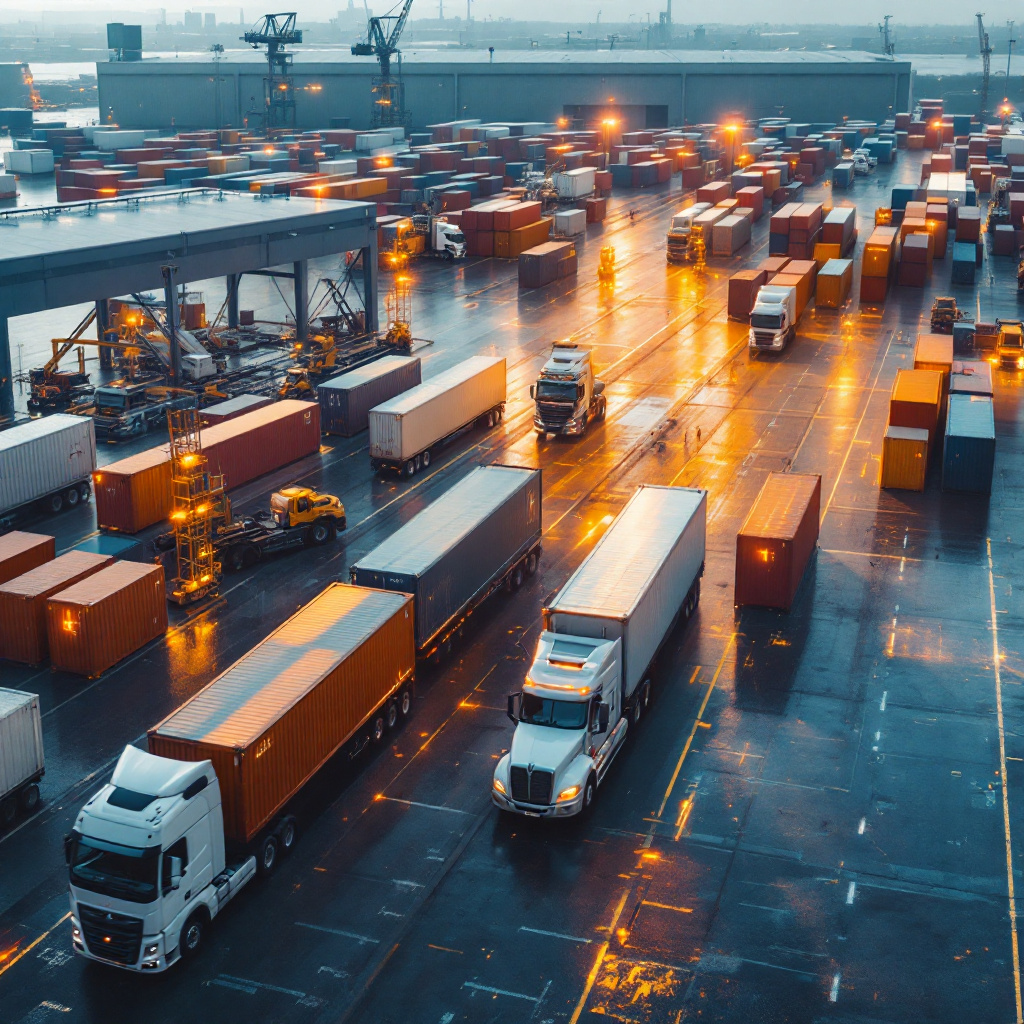AI i logistikk og spedisjon
The AI i logistikk landscape has evolved rapidly, with tools being adopted across the freight forwarding sector to support efficiency, improve freight planning, and make better use of real-time data. Artificial Intelligence is transforming supply chain management by enabling freight forwarders to analyse vast amounts of data and make smarter, faster decisions. In the freight forwarding industry, AI-driven load planning processes can handle significantly more data than humans, which is resulting in reduced operational costs and enhanced delivery accuracy as noted by CargoON.
Freight forwarders facing market competition must prioritise technology adoption. A Magaya-rapport revealed that 45% of shippers have stopped working with a forwarder due to poor technology capabilities. For this reason, leveraging AI capabilities has become a strategic imperative for forwarders. Predictive analytics now supports real-time route optimisation and demand forecasting, so companies can respond to changing market or environmental conditions with agility.
The power of AI allows logistics operations to move from reactive responses towards predictive and proactive planning. AI algorithms use natural language processing to interpret communication and schedule operational tasks with greater speed. AI in freight forwarding is accelerating digital transformation, enabling forwarders to streamline the freight management process and provide better customer experience. This includes offering reliable ETAs, efficient customs clearance procedures, and minimising manual data entry errors in critical documents such as the bill of lading, air waybill, and commercial invoices.
Through systematic use of AI technologies, the freight industry is better positioned to navigate disruptions and handle global trade complexities. By implementing AI automation now, forwarders can improve freight handling, ensure operational efficiency, and remain competitive in an evolving logistics industry. The next section will explore how forwarders automate workflows to enhance productivity.

Automate Workflows: How Forwarders Use Automation
Freight forwarders today automate workflows to eliminate repetitive processes and focus on value-adding tasks. Robotic process automation (RPA) covers operations such as booking confirmations, invoicing, and document handling, which significantly reduces manual data entry. By using AI-powered automation, forwarders streamline workflow across departments, avoiding errors that often occur during the processing of large shipment volumes.
Email management is a major area where automation of routine tasks has shown value. Up to 60% of emails handled by freight forwarders are irrelevant, according to Sedna. AI-powered email organisers can automatically sort, extract, and consolidate data from multiple sources, supporting better resource management and faster responses. Related AI assistants can even automatisere e-postsporing for logistikkteam, ensuring urgent matters are addressed first.
Automation also facilitates instant quoting for FTL and LTL shipments, significantly speeding up sales cycles. With generative AI, customised logistics solutions based on historical data and market conditions can be generated instantly. This benefits freight shippers by offering competitive, transparent pricing.
Integration with legacy systems remains a concern for many forwarders. However, low-code and no-code AI solutions now enable users to connect to existing software systems such as transportation management systems or customer relationship management platforms without complex development cycles. By automating and connecting these systems, forwarders can streamline the freight and communication processes. AI can automatically extract invoice details, verify customs clearance data, and prepare compliant shipping documents, reducing turnaround and improving service reliability. The result is a refined operational structure ready to scale without proportional cost increases.
Drowning in emails? Here’s your way out
Save hours every day as AI Agents draft emails directly in Outlook or Gmail, giving your team more time to focus on high-value work.
AI Solutions for Shipment and Freight Management
End-to-end freight management platforms are using AI solutions to increase visibility and provide accurate real-time updates on shipments. By integrating AI, forwarders can gain a consolidated view of their entire freight operations, including inventory management, fleet management, and freight expense calculations. Machine learning models deliver insights to improve freight tracking accuracy, while predictive analytics supports dynamic pricing strategies based on demand and historical trends.
Advanced AI tools assist in predictive maintenance to prevent costly delays. For example, predictive maintenance alerts can identify potential equipment issues before they become critical, keeping shipments on schedule. AI systems also analyse external variables such as weather changes or port congestion, enabling smarter, data-driven decisions for freight management. This approach addresses the operational efficiency needs of the freight industry while maintaining service consistency during disruption.
Some freight forwarding software leverages generative AI to create customised route plans and optimise load management. Real-time data analytics helps freight forwarders work efficiently while avoiding unnecessary costs. These AI capabilities are designed to handle vast amounts of data, producing rapid and accurate operational insights that enhance competitiveness.
In addition, innovations in natural language processing help freight forwarders manage large-scale communications. They simplify the handling of documents like commercial invoices, bills of lading, and air waybills while reducing manual data entry requirements. For a practical example of improving operational flow through email management, forwarders may adopt AI-maskeringsverktøy for e-poster to ensure compliance and data accuracy.

How to Adopt AI: Best Practices for Freight Forwarders
When forwarders adopt AI, preparation is critical. High-quality data and robust governance frameworks ensure AI algorithms operate accurately and ethically. Poor or inconsistent data reduces the effectiveness of AI automation, so companies must invest in data cleansing before implementing AI. Integrating AI effectively with transportation management systems and management software increases the potential benefits while reducing errors.
A phased rollout is recommended. Starting with small-scale automation of routine tasks allows teams to measure impact and refine processes before expanding to more complex operations. Tilsyn med menneskelig involvering er fortsatt essensielt for å håndtere unntak, ivareta personvernstandarder som GDPR, og forhindre driftsfeil. AI helps forwarders by providing insights, but decision-making should remain informed by human judgment.
Scalability is another best practice. Choose AI solutions that can accommodate growing shipment volumes without proportionally increasing costs. Seamless integration with CRM tools and freight forwarding software allows better tracking of customer experience metrics and operational performance. Staff training in AI capabilities prevents skill gaps and builds in-house competency over time, making teams adept at implementing AI technologies.
Change management programmes are vital to overcome resistance to digital transformation projects. This includes communicating the benefits of AI-powered automation for manual data entry reduction, operational efficiency, and improved freight services. Employees should understand how the use of AI improves their workflow, making their roles more analytical and less administrative. Forwarders should also implement ongoing learning initiatives to keep up with the latest AI advancements and maintain competitiveness in global trade.
Drowning in emails? Here’s your way out
Save hours every day as AI Agents draft emails directly in Outlook or Gmail, giving your team more time to focus on high-value work.
Reduce Costs and Enhance Efficiency with AI
AI can assist freight forwarders in reducing operational expenses and improving service quality. AI-optimised routing and load planning cut fuel consumption and greenhouse gas emissions. According to CargoON, AI-driven load planning manages amounts of data that far exceed human capacity, leading directly to cost savings. Behavioural coaching tools tailor dispatcher performance to enhance fleet management and reduce idle time.
Scalability is a core AI advantage. As freight volumes grow, AI systems can process additional shipments without proportional cost increases. AI-powered platforms streamline the freight management process, providing real-time updates to customers and partners. This increased reliability strengthens customer experience and boosts retention. In competitive markets, improved communication and dependable delivery estimates are key differentiators. Tools such as AI-assistenter for raskere responstider i logistikk are becoming common assets for competitive forwarders.
Freight expense calculations become more accurate with AI, as predictive analytics and historical performance data underpin pricing models. This transparency benefits both forwarders and freight shippers, promoting trust and repeat business. By reducing manual data entry during invoice preparation and customs clearance processes, AI automation accelerates transactions and minimises errors.
The overall impact of AI adoption includes better resource management and higher operational efficiency. By combining predictive maintenance with AI monitoring, equipment downtime is reduced, preserving service continuity. AI can automatically match incoming shipments to optimal loads, schedule delivery routes, and issue proactive status alerts. These actions align directly with a forwarder’s goal to reduce costs while maintaining high service standards.
Future of Freight Forwarding and Challenges for Freight Forwarders
The future of freight forwarding will be marked by greater integration of autonomous vehicles, robotics, and advanced AI capabilities in freight operations. Physical handling tasks, such as loading and unloading, may be increasingly automated. However, challenges for freight forwarders remain, including ethical concerns, compliance with regulations like GDPR and C-TPAT, and the need for human oversight despite automation.
There is also a growing demand for AI specialists and data scientists within forwarding teams. To keep pace, forwarders must invest in training and talent acquisition, developing expertise in implementing AI solutions and analytics. Staying competitive will involve preparing for frequent algorithm updates and ensuring that AI applications remain aligned with business objectives and regulatory requirements.
Continuous monitoring is vital to avoid errors during the automation of routine processes. AI in logistics will evolve, but maintaining a balance of machine efficiency and human judgment is critical. Freight forwarding operations will continue reshaping freight forwarding practices by streamlining the freight, speeding up customs clearance, and improving freight tracking accuracy. Those who adopt AI early will find themselves better positioned to respond to dynamic supply chain conditions.
While integrating AI provides numerous benefits, forwarders should be prepared to manage both opportunities and risks in the AI-powered future. The use of AI should focus on achieving sustainable operational efficiency, offering customised logistics solutions based on reliable data analytics, and supporting collaboration across the global trade network. By doing so, forwarders will maintain resilience and adaptability as they navigate the evolving demands of the freight industry.
Ofte stilte spørsmål
What is AI in freight forwarding?
AI in freight forwarding refers to the use of artificial intelligence technologies to automate tasks, improve planning, and optimise logistics operations. This includes route optimisation, real-time data analysis, and predictive analytics for demand forecasting.
How does AI help freight forwarders reduce costs?
AI reduces costs by optimising load planning, reducing fuel consumption, and automating manual tasks like data entry and invoice processing. These efficiencies lower labour expenses and improve overall resource utilisation.
Can AI improve customer experience in logistics?
Yes, AI improves customer experience by providing accurate ETAs, real-time updates, and faster responses to inquiries. This leads to increased reliability and satisfaction among shippers and consignees.
What are the main challenges in implementing AI?
The main challenges include ensuring high-quality data, integrating AI with legacy systems, and maintaining compliance with regulations. Human oversight is also needed to handle exceptions effectively.
What role does predictive analytics play in freight management?
Predictive analytics helps forecast demand, optimise routes, and anticipate disruptions. By using historical and real-time data, forwarders can plan operations more efficiently.
Can AI integrate with existing transportation management systems?
Yes, modern AI solutions often include low-code or no-code options that integrate with existing transportation management systems, enabling seamless automation without disrupting core workflows.
How can freight forwarders start adopting AI?
They should begin with small, high-impact automation projects, ensure quality data, and train staff in AI capabilities. This phased approach minimises risk and builds experience over time.
What is the future of freight forwarding with AI?
The future includes greater use of autonomous vehicles, robotics, and advanced AI algorithms for both physical and administrative processes. Forwarders will likely see higher efficiency and scalability.
Is AI replacing human roles in freight forwarding?
No, AI is designed to assist rather than replace humans. A human-in-the-loop approach ensures that critical decisions retain the benefit of human judgment.
How does AI improve shipment visibility?
AI provides end-to-end tracking and real-time updates, integrating multiple data sources for a complete view of shipments. This improves decision-making and enhances customer communication.
Ready to revolutionize your workplace?
Achieve more with your existing team with Virtual Workforce.